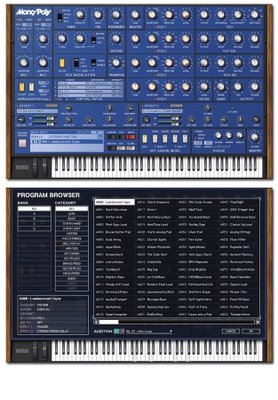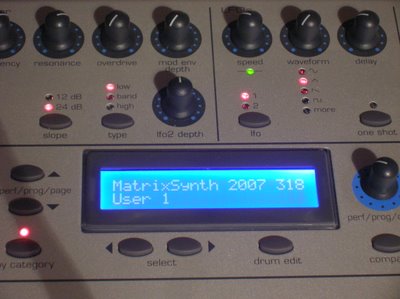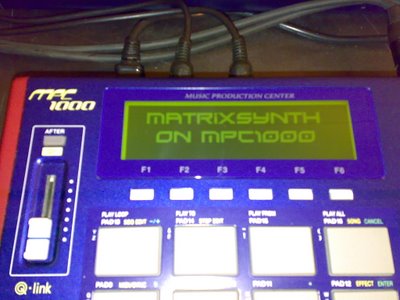 Title link takes you to the post on GetLoFi.
Title link takes you to the post on GetLoFi.
Thursday, January 18, 2007
What Makes an Envelope Snappy
 Florian posted the following to AH. I thought it was probably the most detailed explanation I've come across on what makes an envelope snappy. I asked him if it would be ok to put it up here for others and the archives, and he gave the thumbs up. He also mentioned that the following is basically a short resume from some chapters of his book "Synthesizer." You can find it on amazon
Florian posted the following to AH. I thought it was probably the most detailed explanation I've come across on what makes an envelope snappy. I asked him if it would be ok to put it up here for others and the archives, and he gave the thumbs up. He also mentioned that the following is basically a short resume from some chapters of his book "Synthesizer." You can find it on amazonWhat Makes an Envelope Snappy:
"There are several aspects:
1.) Speed, shape, of envelope
2.) envelope amount and offset value destination of destination
parameter, sustainlevel (in case of ADSR),
3.) characteristics of modulation,
4.) synchronisation with waveform.
First aspect:
In analogue envelopes (created by loading unloading a capacitor) speed
and shape are related to each other. If whe look at decay, the same
decay value at the beginning of the decayphase causes a much faster
change than at the end of the decay phase, because of the exponential
unloading characteristics of the capacitor.
Second aspect (All values in the following examples from
0=shortest/lowest to 100=longest/highest):
If we now modulate a filte with such an envelope like A=0, D=10, S=0,
R=0. If the cutoff frequency is already at 500Hz), and the envelope
amount is very high - lets say 5 octaves. THis will cause the filter to
open up to 16000 Hz and back to 500 Hz. The most noticable change will
happen between 2000Hz and 500Hz, all above is simply "bright". So all
the fast part of the exponential envelope will happen whil you don't
realize it. And only the slow end of the decay curve will cause a
noticable change. So even if your envelope in general is "fast like
hell", you will destroy this, by wrong modulation settings on the
destination.
Third aspect:
Next question is: how does the destination react on the envelope. A good
example are VCAs, which are available with linear and exponential
characteristics. Our loudness recognition is basically logarithmic. So
We need exponential controls for volume. Since analogue envelopes
already have exponential characteritics, you can use a linear VCA, which
translates the exponential change of the envelope direct to the signals
amplitude change. But for linear changing LFO waveforms you need a
exponentiator, which translates the linear changing waveform to a
exponentially changing waveform and then modulates the amplitude.
Now: If you use a exponential VCA for envelope modulation, you will have
a double exponential function, which will increase the "snappyness" of
the envelopemodulation (but will increase also the effect, which is
described in the second aspect).
Fourth aspect:
Whether a envelope is felt as snappy or has a click in the beginning,
depends also very much on the synchronisation with the waveform of the
VCO(s). Especially if the VCOs tend to eliminate by interference its
often a good idea to patch the gate to the Hardsync in, which causes the
VCO to start at each keypress at a dedicated point of the waveform.
Florian"
Sound Master Rhythm
 Interesting little Rhythm pedal sent my way hino. Title link takes you to more images pulled via this auction.
Interesting little Rhythm pedal sent my way hino. Title link takes you to more images pulled via this auction.
MPC Analogue Drummachine

via this auction
"Super cool analogue drummachine from the 80's. Sounds a bit between a tr-808 and cr-78. Unit comes with a custom Kenton Pro Kadi witch also has a not to stop the sound of the ride. Here is a link to a little sounddemo."
Previous MPC Post
KORG VCF
 Here's an interesting item up this auction. No title link. Just this image and details:
Here's an interesting item up this auction. No title link. Just this image and details:"Korg Synthepdal from the 70's. used in the maxikorg, minimorg 770 and the early ms serie's. It got lowpass and highpass filtering and a footnctroller witch works on some older Korg synthesizers to. Picture is from the web but the unit looks pretty good due it's age "
Doepfer A-100 System Expansion
 Details:
Details:This is a G6 case full of add on modules to the A-100 Basic System 2.
the modules included are as followed....
A-109 Voltage Controlled Singal Processor
A-114 Ring Mod
A-116 VC Waveform Shaper
A-117 Digital Noise / 808 Source
A-122 24db Low Pas II
A-128 Fixed Filter Bank
A-132 Dual VCA [x2]
A-135 Voltage Controlled Mixer
A-138c Polarized Mixer
A-139 Head Phone Amp
A-143-3 Quad LFO
A-144 Morph Controller
A-152 Addressed T&H/Switch
A-162 dual Trigger Delay
Update: Doh! This was supposed to go up on MATTRIXSYNT-B. Sorry. : )
Roland V-Synth GT
 "Roland’s original V-Synth set a new standard in expressive synthesis and sound design. It won awards and acclaim around the world, as it forever changed the way sounds were created and performed. But just when you thought V-Synth technology had reached its peak, Roland raised the bar even higher with the new flagship V-Synth GT! This unique instrument injects the V-Synth’s famous Elastic Audio Synthesis engine with revolutionary Articulative Phrase Synthesis technology. Its expression and realism is unprecedented, as is its ability to make never-before-heard sounds.
"Roland’s original V-Synth set a new standard in expressive synthesis and sound design. It won awards and acclaim around the world, as it forever changed the way sounds were created and performed. But just when you thought V-Synth technology had reached its peak, Roland raised the bar even higher with the new flagship V-Synth GT! This unique instrument injects the V-Synth’s famous Elastic Audio Synthesis engine with revolutionary Articulative Phrase Synthesis technology. Its expression and realism is unprecedented, as is its ability to make never-before-heard sounds.* Multiple forms of advanced synthesis under the control of a friendly, icon-driven interface
* New AP (Articulative Phrase) SYNTHESIS technology models the performance behavior and nuance of musical instruments
* Includes Roland’s proprietary Elastic Audio Synthesis engine plus Vocal Designer, playable simultaneously
* Sound Shaper II offers incredibly easy and efficient user programming
* Futuristic, high-quality industrial design
* Color touch-screen display with wide viewing angle
Multi-core Synthesis
By integrating a new dual core V-Synth engine, the V-Synth GT can combine Elastic Audio Synthesis, Vocal Designer technology, and AP-SYNTHESIS in real time. Roland’s proprietary VariPhrase technology is also integrated into the V-Synth GT. Together with its analog-modeling engine, External Audio input, and digital sampling architecture, the V-Synth GT provides an incredibly wide and colorful foundation on which to capture, manipulate and create sounds.
AP-SYNTHESIS
The V-Synth GT is the first synthesizer in the world equipped with AP (Articulative Phrase) SYNTHESIS. This revolutionary form of modeling recreates the ever-changing behavior, nuance and sound of an instrument as it’s being played. The results are stunningly expressive and realistic, and can be applied to acoustic instrument simulation as well as new, never-before-heard sounds."
Title link takes you to more.
Previous V-Synth posts
Link to new products by Roland
New Korg Legacy Samples are Up
 "Mono/Poly software synthesizer
"Mono/Poly software synthesizerThe Mono/Poly, a four-VCO monophonic/polyphonic synthesizer that went on sale in 1981 was considered the culmination of Korg’s experience building analog synthesizers. It was released at the same time as the Polysix, and because of their capabilities as well as their price, these two instruments caused a revolution in the synthesizer world. Many musicians acclaimed the Mono/Poly as one of Korg’s best synthesizers, with a number of unique characteristics.
t provided four VCOs, each providing adjustable pitch, waveform, octave, and level, which could be stacked together for massive sounds, or cycled through one at a time for constantly shifting timbres. Together with one VCF, one VCA, two EGs, and two MGs it delivered a powerful yet accessible programming structure. But by far, its most signature characteristics were the Synchro and Cross Modulation functions that could run dual, or four-way cascaded modulation routings for creating revolutionary and aggressive tonal effects. It also featured the same futuristic Chord Memory and Arpeggiator functions as the Polysix. This diversity of parameters could be used to create an incredible universe of sounds ranging from thick and rich to sound-effect-like.
Along with being a complete reproduction of the original Mono/Poly, this new software version extends the Mono/Poly to its ultimate form. It features 128-voice polyphony with up to 16-voice unison, and a powerful eight-way virtual patching matrix. The virtual patch functionality lets you use 159 different modulation sources such as MG, EG, velocity, and keyboard tracking to modulate 35 different destinations such as oscillator pitch, level, filter, MG, or EG, giving you an awesome capability for creating complex and diverse sounds."
Title link takes you to more info and samples.
Matrixsynth by...

Matrixsynth by Davide. Novation KS-5

Matrixsynth by Rob. MPC1000 running JJ OS 4.34.
No not new for NAMM. : ) I'll be posting my usual between NAMM stuff. I have a full inbox of stuff people sent in. I'm going through them now so if you sent me something, it's coming up.
P.S. Ccheck out this Failed Muso post for a video of his MPC 1000. Also he has a few Synth Babe posts running.
Waldorf Knob
 Nothing new on the site. Just thought I'd grab the big red knob for posterity. Always thinking of the future. ; ) I'll be sure to put up posts to the photo sets that come in out there, so keep coming back.
Nothing new on the site. Just thought I'd grab the big red knob for posterity. Always thinking of the future. ; ) I'll be sure to put up posts to the photo sets that come in out there, so keep coming back.New Waldorf Products
PREVIOUS PAGE
NEXT PAGE
HOME













© Matrixsynth - All posts are presented here for informative, historical and educative purposes as applicable within fair use.
MATRIXSYNTH is supported by affiliate links that use cookies to track clickthroughs and sales. See the privacy policy for details.
MATRIXSYNTH - EVERYTHING SYNTH













© Matrixsynth - All posts are presented here for informative, historical and educative purposes as applicable within fair use.
MATRIXSYNTH is supported by affiliate links that use cookies to track clickthroughs and sales. See the privacy policy for details.
MATRIXSYNTH - EVERYTHING SYNTH

























